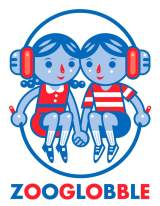[To Dan Zanes and Salon.com readers -- greetings and thanks for stopping by. And check out the main site for tons more music for kids and adults. No, that's not an oxymoron.]
The short review of Catch That Train!, Dan Zanes' 2006 release and his fifth album specifically for kids and families is that it's like his previous family music album, but more so -- more musically diverse, more lyrical, more... everything.
The long review is... well... the thing is, after listening to this album so many times, I didn't want to write the short review, which might otherwise have just said, "It's like every other Dan Zanes CD -- it's great." So I went back to his first family music album, 2000's Rocket Ship Beach, to see if I could notice progression in Zanes' music that is harder to see from just looking at his last album, House Party. And a couple things struck me as I listened to his first and his latest CDs.
The first thing that struck me was how Zanes has gradually broadened his musical horizons since 2000. Six years ago, the debut's most adventurous musical step could very well have been the appearance of Father Goose (Rankin' Don) and his dancehall stylings. On Catch That Train!, Rankin' Don's appearance on "Choo-Choo-Ch-Boogie" almost feels safe compared to the rest of the album. The Blind Boys of Alabama on the gospel "Welcome Table," the Rubi Theater Company on the strutting "Walkin' the Dog," the forward-thinking Kronos Quartet on the retelling of the psycho-pet story "Grey Goose" -- they all come from diverse musical places and yet fit in perfectly on this disk. It's as if Zanes has released his very own Putumayo collection. Which is not to say that the stuff that's been around since Rocket Ship Beach -- Rankin' Don, the duet with Barbara Brousal ("Mariposa Ole," in Spanish, of course), and the duet with a female singer-songwriter (Natalie Merchant on the lovely "Loch Lomond") -- isn't there, and isn't great. Because it is.
The other thing that struck me was that the first CD seemed to me a collection of songs that Zanes really liked. The latest CD does seem to have a thematic cohesiveness to it, and it's not about trains. It's about community. "When we ride / We ride together," Zanes has written on the title track, and there is a strong sense of doing things together that runs through the album. Inclusiveness ("All God's children gonna sit together," from "Welcome Table"), neighborliness ("High and low, people that we know / They say 'Hey there,' and 'How’ve you been?'," from "Wander in the Summer Wind"), and a welcoming neighborhood ("Wherever you’re from / Know that you’re welcome / If you want to bring your family ‘round / To this moonlit town," on the album closer "Moonlit Town.")
Quite possibly my favorite song on the album is Zanes' "While the Music Is Playing," about wanting to linger in the neighborhood into the night, listening to all the different music in the air.
People gather all around the square
People laughing in the evening air
Swirls and mingles with the songs that brought us there
That brought us all there.
If that's not Zanes' ideal world in a nutshell, I'm not sure what is. The midtempo tune mixes a wistful chorus, brass band, and a backup singer count which eventually must reach double-digits to posit a world where community is paramount. (Its placement smack-dab in the middle of the album just before the pro-working-man "I Don't Want Your Millions Mister" can't be just random.) With Zanes
entering the fray over a proposed Brooklyn development, these are no longer idle concerns for him.
As with all Dan Zanes albums, Catch That Train is for people of every age. But if I had to narrow down the age range, I'd call it ages 5 through 10. You can hear samples, etc., by following the links at Zanes' Catch That Train! page.
In the end, if you're at all a fan of Dan Zanes' music, you'll enjoy this album. (And if you're in the minority who don't, this album won't change your mind.) Catch That Train! is Zanes' strongest album to date, a celebration in music of the joys of family, community, and music itself. Highly recommended.
[May 19, 2006 Update]
Now that I've had the full copy of the CD and packaging for a few days, rather than just an advance promo copy, I wanted to add a few additional comments to the review.
1) The packaging is quite nice -- Zanes has replaced the book format of his previous kids' CDs with more of a foldout design similar to which he employed on Parades and Panoramas. The entire design is thought out quite well (the title, "Catch That Train!," is actually the very end of a sentence that runs through the entire physical package).
2) Lyrics! Chords! The presence of these two things in the liner notes only makes the absence of them in previous albums that much more stark. Again, Zanes had started doing this with Parades and Panoramas and Sea Music, but their presence here is very welcome (especially for an artist so enamored of public singing). And, Zanes' comments in the liner notes are useful, too. (Not to mention finding out little things like Warren Zanes plays guitar on "Mariposa Ole.")
3) The video for "Catch That Train!" is OK, but nothing special. Dan Zanes plays around in his apartment while a tiny little animated train drives around. The scene where Zanes looks at a comb by his sink, then shakes his head as if to say, "naaaah," did make me laugh, though.
So, there you have it. And if you don't (have it), why not?
 Friday, May 19, 2006 at 11:02PM
Friday, May 19, 2006 at 11:02PM 



